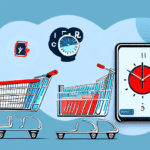Understanding Bounce Rate: How to Measure It and Why It Matters for E-Commerce Operations
As an e-commerce business owner, understanding your website's bounce rate is crucial for the success of your online store. Bounce rate measures the percentage of visitors who enter your site and then leave without taking any action, such as making a purchase or clicking through to another page.
What is Bounce Rate and Why It Matters for E-Commerce
Definition of Bounce Rate
Bounce rate is a key metric that indicates the effectiveness of your website in engaging visitors. It represents the percentage of single-page sessions where users leave your site without interacting further. According to Google Analytics, a lower bounce rate suggests that visitors are finding what they need and are more likely to convert.
Significance for E-Commerce
A high bounce rate can signal issues such as poor user experience, slow load times, irrelevant content, or ineffective landing pages. For e-commerce businesses, this can translate to lost sales opportunities and reduced revenue. Understanding and optimizing bounce rate is essential for improving user engagement and driving sales growth.
Factors Influencing Bounce Rate
Site Design
A well-designed website with intuitive navigation and a visually appealing layout can significantly reduce bounce rates. Elements such as clear menus, consistent branding, and responsive design contribute to a positive user experience.
User Experience
User experience encompasses how visitors interact with your site. Factors like ease of navigation, mobile responsiveness, and fast loading times play a critical role in keeping users engaged. According to a study by Forrester Research, a one-second delay in page load time can reduce customer satisfaction by 16%.
Content Quality
High-quality, relevant content tailored to your target audience helps retain visitors. Engaging product descriptions, informative blog posts, and valuable resources encourage users to explore your site further.
Traffic Sources
The origin of your website traffic impacts bounce rate. Visitors from targeted sources like search engines or social media are more likely to stay and engage compared to those arriving through irrelevant channels or clickbait ads.
Measuring and Analyzing Bounce Rate
How to Calculate Bounce Rate
Bounce rate is calculated by dividing the number of single-page sessions by the total number of sessions on your website. For example, if 40 out of 100 visitors leave after viewing only one page, your bounce rate is 40%.
Tools for Tracking Bounce Rate
Utilize web analytics tools like Google Analytics to monitor bounce rate along with other key metrics such as page views, session duration, and conversion rates. These insights help identify areas needing improvement.
Benchmarking Against Industry Standards
Bounce rates can vary by industry. According to WordStream, the average bounce rate for e-commerce websites ranges between 20-45%. Comparing your site's performance against these benchmarks helps set realistic goals and identify competitive positioning.
Strategies to Reduce Bounce Rate
Improving Site Navigation
Ensure your website is easy to navigate with clear menus and logical page structures. Implementing a search bar can also help users find what they're looking for quickly.
Enhancing Content Relevance
Create content that aligns with user intent by conducting thorough market research and developing detailed buyer personas. Tailored content keeps visitors engaged and encourages them to explore more of your site.
Optimizing Load Times
Fast-loading websites enhance user experience and reduce bounce rates. Optimize images, utilize browser caching, and minimize the use of heavy scripts to improve site speed. Tools like Google PageSpeed Insights can help identify areas for improvement.
Optimizing Landing Pages
Design landing pages with a clear value proposition, persuasive copy, and relevant imagery. Limit the number of calls-to-action to prevent overwhelming visitors and guide them towards desired actions.
Bounce Rate and Business Performance
Impact on Conversion Rates
A high bounce rate often correlates with lower conversion rates. When visitors leave without engaging, the opportunity to convert them into customers diminishes. Improving bounce rate can lead to higher conversions and increased sales.
Relationship with Revenue Growth
Reducing bounce rate contributes directly to revenue growth by retaining more potential customers. Enhanced user engagement through optimized site elements can lead to repeat visits and long-term customer loyalty.
Advanced Techniques for Managing Bounce Rate
User Behavior Analysis
Analyze user behavior through heatmaps and session recordings using tools like Hotjar. Understanding how users interact with your site helps identify pain points and areas for improvement.
A/B Testing
Conduct A/B tests on different landing page elements such as headlines, images, and calls-to-action to determine what resonates best with your audience. This data-driven approach helps refine site design and content for optimal engagement.
Retargeting Strategies
Implement retargeting campaigns to re-engage visitors who have previously bounced from your site. Personalized ads can remind them of your offerings and encourage return visits, increasing the chances of conversion.
Future Trends in Bounce Rate Optimization
Data Analytics and Machine Learning
Advanced data analytics and machine learning algorithms will play a significant role in predicting and reducing bounce rates. These technologies can provide deeper insights into user behavior and automate optimization processes.
Personalization
Personalized user experiences tailored to individual preferences and behaviors will become increasingly important. Customizing content and recommendations can significantly enhance engagement and reduce bounce rates.
Emerging Tools and Techniques
New tools and techniques for measuring and improving user engagement will continue to emerge. Staying updated with the latest advancements ensures that e-commerce businesses can effectively manage bounce rates and maintain competitive advantage.
Case Studies of Successful Bounce Rate Improvement
Clothing Retailer Redesign
A clothing retailer redesigned its website to feature better navigation and detailed product information, resulting in a 15% increase in revenue. The enhanced user experience kept visitors engaged longer, reducing the bounce rate significantly.
E-Commerce Specific Landing Pages
Another e-commerce business created more specific landing pages tailored to user intent, which led to a 25% increase in revenue. By addressing the exact needs of visitors, the company improved both bounce and conversion rates.
These case studies demonstrate the effectiveness of targeted strategies in reducing bounce rates and driving business growth. By applying similar tactics, other e-commerce businesses can achieve comparable results.
Conclusion
Monitoring and optimizing bounce rate is essential for e-commerce success. By understanding the factors that influence bounce rate and implementing strategic improvements, businesses can enhance user engagement, increase conversion rates, and drive revenue growth. Staying informed about future trends and continuously analyzing performance metrics will ensure sustained success in a competitive online marketplace.




















